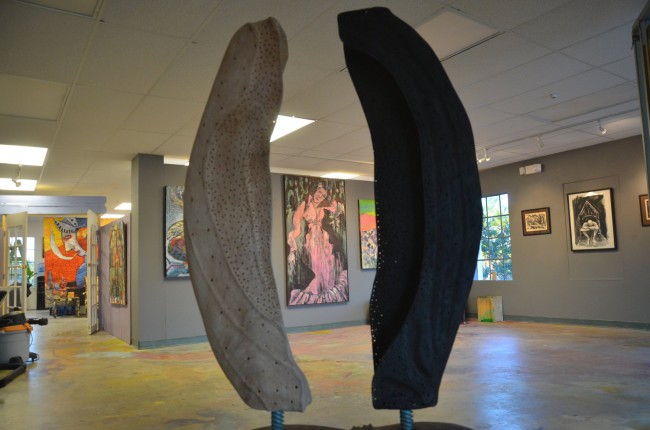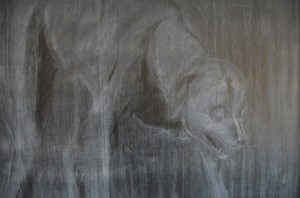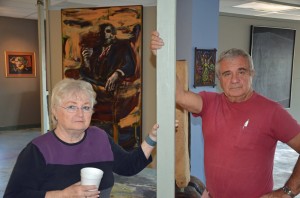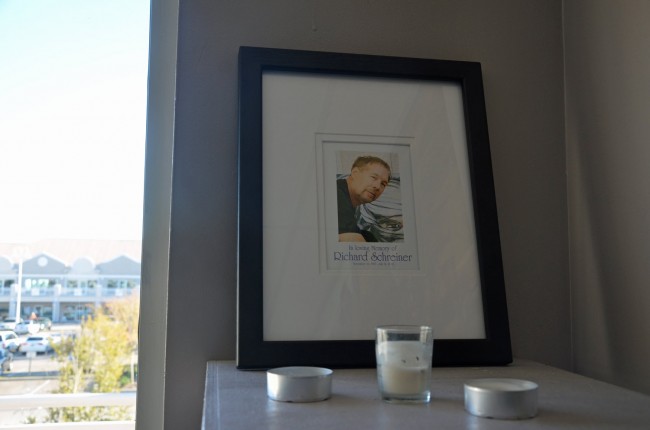
There really was no other choice, even though he’s dead. Or maybe because he’s dead: Naming Richard Schreiner Flagler County’s Artist of the Year, as the Gargiulo Art Foundation just did, is, to put it gently, a little overdue.
But Tom Gargiulo has a valid excuse. He’d never known the breadth of Schreiner’s work until recently. He’d never seen it, or knew it existed. Schreiner had abandoned painting for years, then started again when he moved his studio into Hollingsworth Gallery more than three years ago, but his second coming never happened in earnest until five weeks before his death, when Hollingsworth’s JJ Graham, Schreiner’s closest friend in Palm Coast, finally curated a retrospective of his work, having until then thought what most of us had thought: that there’d always be time for the massive retrospective, particularly since Schreiner kept producing new work after catching his second wind.
Time ran out before anyone knew when a rare heart malfunction, the sort of rueful disease Schreiner would have parodied and flayed in a painting, ground him down, robbed him of his powers, then killed him. His wit and—for a man so intimate with anger—his serenity escaped the disease’s grip until the end, but in the end he could not escape the disease.
Before his death on July 12, one month after the opening of his only retrospective in Palm Coast, he’d become—like the upper floors of the World Trade Center before their untimely death—his own weather system at Hollingsworth. His corner in back of the gallery, the first artist’s studio to colonize a space of its own there beside that of Graham, was like Schreiner himself: a combination of the quiet and the uncontained. Canvasses piles against each other like decks of oversize cards in a Lewis Carol scene, just darker: primary colors didn’t exist with Schreiner. Only primal emotions. His prolific nature spilled out again after those years of rejecting his own art. Had he not died, his works’s sheer numkbers would have rendered everyone else’s at Hollingsworth like so many minorities, Graham’s included.
He was painting the last years’ muck: the money grubbers, the oil spillers, the forked tongues, the insurgents. “Politics” to him was quackery, a boy with a dog had none of the nostalgia the cliché evokes and all of the foreboding of something as hollow as the empty box next to the pair. Men in conflict were no longer men but beasts. His “Congressman” was an homage to Boris Karloff, his “Statesman” a pig, his “Worker” a run. Schreiner hammered his points, at times with a jarring lack of subtlety that flirted with self-indulgence, and at times with the frightening shocks of wreck scenes that make you want to look away and absorb the scene all at once, but—as too many people end up saying, for fear of what other people might say—not hang it in your living room.

The most striking surprises of the show are Schreiner’s etchings. He did hundreds of them, Graham says, and only a few are on display here, but enough to show Schreiner’s artistry in a new, more understated dimension. It’s like looking at Bruegel’s scrap pad, updated with a few centuries of matter.
You’ll also see what Graham describes as “a rabid dog frozen in an ice cube,” imprisoned in greys and shards of white, as if the ice were foaming rather than the dog. It’s a strange piece, like many Schreiners, leaving you glad the dog cannot spring from his ice.
Rather than curate a whole new retrospective, Gargiulo and Graham decided to put together a “Schreiner and Friends” exhibit: artists who knew and worked with Schreiner, who saw his den in back of the gallery and were influenced by it, and who now feel his enormous loss. So the exhibit mixes old-new Schreiner with the familiar: Peter Cerreta, William Brandt, Christine Sullivan, Linda Solomon, Weldon Ryan, Gargiulo, Graham and several others.

“It was a very easy choice,” Gargiulo said. “It seems like we have a lot of talented artists, always. But something happens that one just stands out above all the others. And Richard was the one this year. Richard was everyone’s first choice.”
Gargiulo explained why his familiarity with Schreiner’s work was late-blooming: “I always knew he was a good artist just by talking to him. We shared similar experiences. Then when JJ had the retrospective, everyone was just in awe. We were just shocked to see all this work. He had 114, 115 pieces that were hung, plus all the others that JJ could hang. When I see his work, well, from a different angle, I’d like to see his work in some public art collection, right here in Palm Coast. That’s not going to happen right now. People want to keep the status quo. I’m trying to get JJ’s work into our ‘art in public places,’ and JJ’s, they don’t appreciate it. It’s not pretty bouquet of flowers, landscape with a barn, palm trees, sand dunes, light houses, you know. It’s real art. Personal.”
Flagler Artists of the Year:
|
Likewise with Schreiner’s “dark expressionism.” Public walls like their visual Muzak. Schreiner despised Muzak of any kind, the visual kind especially. He is what Louis CK would have been, had Louis CK been a painter: raw, demanding, uncompromising, an artist’s artist. “He’s more apt to paint an alleyway with trash barrels and rats running around rather than a nice sunny beach with beach blankets,” Gargiulo says with understatement.
“I’m glad it’s Richard,” Weldon Ryan, the 2011 Artist of the Year, said, “because honestly, his work opened up the scope of art in the county. He very well deserves it. He was so quiet about how he is and so forth, and he’s a prolific painter. Seeing his work in full bloom was just the most amazing thing. I’m just happy that it’s him.”
“What I respect about Richard,” Graham, who still has a hard time dealing with his friend’s death, “is he never changed his style to suit a market. He definitely had the capacity to do that. You look at his technique, at how well he painted. He could have painted pretty pictures, he could have said OK, that’s it, I’m going to make some money, and screw trying to—maybe he couldn’t have. Maybe that just wasn’t how he was wired, now that I think about it.”






























Leave a Reply